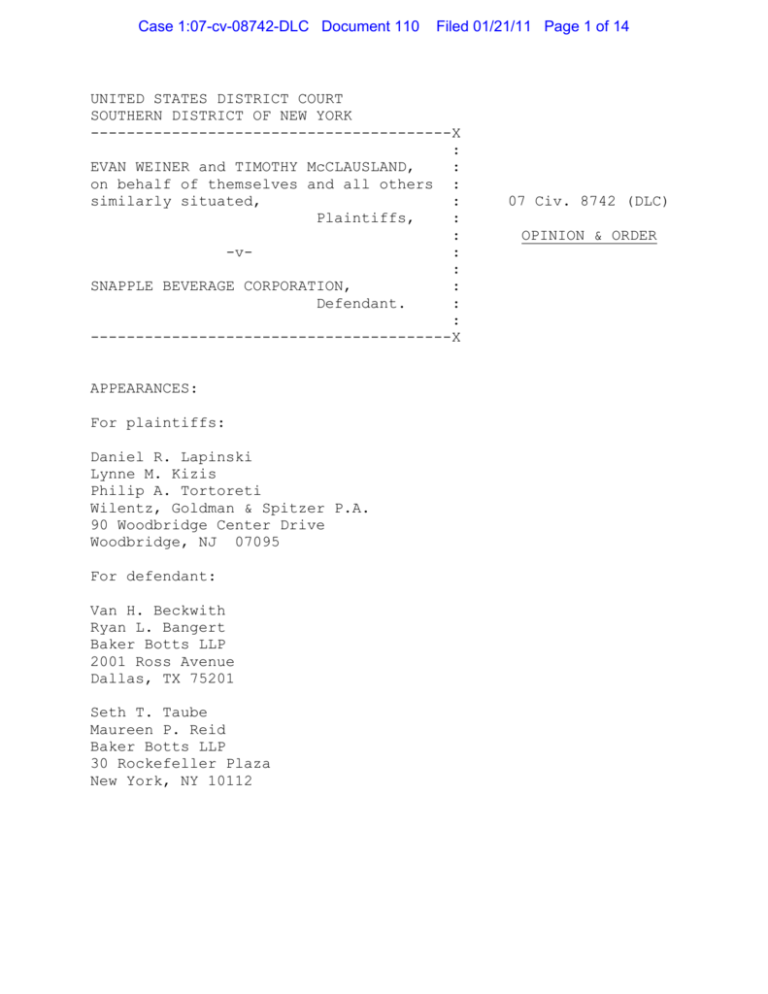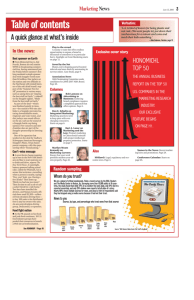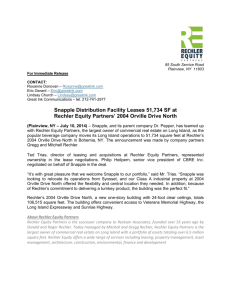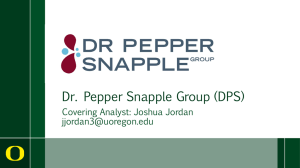UNITED STATES DISTRICT COURT SOUTHERN DISTRICT OF
advertisement

Case 1:07-cv-08742-DLC Document 110 Filed 01/21/11 Page 1 of 14 UNITED STATES DISTRICT COURT SOUTHERN DISTRICT OF NEW YORK ----------------------------------------X : EVAN WEINER and TIMOTHY McCLAUSLAND, : on behalf of themselves and all others : similarly situated, : Plaintiffs, : : -v: : SNAPPLE BEVERAGE CORPORATION, : Defendant. : : ----------------------------------------X APPEARANCES: For plaintiffs: Daniel R. Lapinski Lynne M. Kizis Philip A. Tortoreti Wilentz, Goldman & Spitzer P.A. 90 Woodbridge Center Drive Woodbridge, NJ 07095 For defendant: Van H. Beckwith Ryan L. Bangert Baker Botts LLP 2001 Ross Avenue Dallas, TX 75201 Seth T. Taube Maureen P. Reid Baker Botts LLP 30 Rockefeller Plaza New York, NY 10112 07 Civ. 8742 (DLC) OPINION & ORDER Case 1:07-cv-08742-DLC Document 110 Filed 01/21/11 Page 2 of 14 DENISE COTE, District Judge: This case concerns whether defendant’s labeling of its teas and juice drinks as “All Natural,” despite their inclusion of high fructose corn syrup (“HFCS”), was misleading to consumers. The defendant has moved for summary judgment. For the following reasons, the motion is granted. BACKGROUND The facts of this case were discussed in detail in the Court’s August 5, 2010 Opinion and Order denying class certification. Weiner v. Snapple Beverage Corp., 2010 WL 3119452 (S.D.N.Y. Aug. 5, 2010). Briefly, defendant Snapple Beverage Corporation (“Snapple”), a New York company, manufactures and distributes teas and juice drinks. markets its beverages as being “All Natural.” Snapple At the time plaintiffs filed this lawsuit, Snapple used HFCS to sweeten its beverages. It is undisputed that Snapple disclosed the use of HCFS on its beverages’ ingredient lists. Beginning in 2009, Snapple began the process of substituting sugar for HCFS in all of its products that are labeled “All Natural.” Snapple represents that it “no longer sells any products containing HCFS and labeled as ‘All Natural.’” Plaintiffs Evan Weiner (“Weiner”) and Timothy McCausland (“McCausland”) allege that they paid a premium for Snapple 2 Case 1:07-cv-08742-DLC Document 110 Filed 01/21/11 Page 3 of 14 beverages as a result of the “All Natural” labeling. They contend that the “All Natural” labeling is misleading because the beverages they purchased were sweetened with HFCS. Weiner, a New Jersey resident, purchased Snapple beverages “hundreds of times” in New York and New Jersey. “Numerous reasons” motivated those purchases, but the primary motivation was to “find something that tasted good.” Weiner does not recall the specific price he paid for Snapple products on any given occasion, but thinks that he generally paid between $1.49 and $1.79 per bottle. He last purchased a Snapple beverage labeled “All Natural” and containing HCFS sometime in 2005. McCausland, a resident of New York, similarly made numerous purchases of Snapple products and does not recall the specific prices he paid for those products, with the exception of one purchase of a Snapple beverage for $1.79. Like Weiner, he was motivated by a host of factors in his purchase of Snapple, including taste and marketing. McCausland last purchased a Snapple beverage that was labeled “All Natural” and that contained HCFS in the summer of 2006 or 2007. Plaintiffs filed their original class action complaint on October 10, 2007. The operative pleading for this motion is the Second Amended Class Action Complaint (the “Complaint”), which was filed on October 2, 2009 and was brought on behalf of a putative class consisting of “all persons and entities who, 3 Case 1:07-cv-08742-DLC Document 110 Filed 01/21/11 Page 4 of 14 within the State of New York, purchased for personal consumption and not for resale or assignment, a Snapple beverage marketed, advertised and promoted as ‘All Natural,’ but that contained [HCFS], from October 10, 2001 to January 1, 2009.” Jurisdiction was premised on the Class Action Fairness Act (“CAFA”), 28 U.S.C. § 1332(d). The Complaint asserted claims for violation of N.Y. Gen. Bus. L. § 349, unjust enrichment, and breach of express and implied warranty. On August 5, 2010, the Court denied plaintiffs’ motion for class certification. Defendant moved for summary judgment against the two named plaintiffs, Weiner and McCausland, on September 17, 2010. Plaintiffs do not oppose defendant’s motion for summary judgment on their implied warranty claim. Although plaintiffs originally sought both damages and injunctive relief, the parties stipulated on October 4, 2010, that all claims for injunctive relief have been rendered moot by Snapple’s substitution of sugar for HCFS in its beverages labeled “All Natural.” JURISDICTION Before turning to the merits of the defendant’s motion, it is necessary to address the question of whether the denial of class certification divested this Court of subject matter jurisdiction over this case. As it currently stands, the 4 Case 1:07-cv-08742-DLC Document 110 Filed 01/21/11 Page 5 of 14 lawsuit does not satisfy the requirements of original diversity jurisdiction set forth in 28 U.S.C. § 1332(a): plaintiffs claim damages of less than $75,000, and plaintiff McCausland is not diverse from defendant Snapple. In response to the Court’s Order of January 4, 2011, the parties submitted a joint brief on January 12 which argued that the Court retains jurisdiction over the case despite its denial of class certification. This lawsuit was brought pursuant to CAFA, which provides, The district courts shall have original jurisdiction of any civil action in which the matter in controversy exceeds the sum or value of $5,000,000, exclusive of interest and costs, and is a class action in which . . . any member of a class of plaintiffs is a citizen of a State different from any defendant. 28 U.S.C. § 1332(d)(2). The statute does not speak directly to the issue of whether class certification is a prerequisite to federal jurisdiction, and the Second Circuit has not addressed the issue. The circuits that have considered the issue, however, have uniformly concluded that federal jurisdiction under CAFA does not depend on class certification. See Cunningham Charter Corp. v. Learjet, Inc., 592 F.3d 805, 806 (7th Cir. 2010); United Steel, Paper & Forestry, Rubber, Mfg., Energy, Allied Indus. & Serv. Workers Int’l Union, AFL-CIO, CLC v. Shell Oil Co., 602 F.3d 1087, 1092 (9th Cir. 2010); Vega v. T-Mobile USA, Inc., 564 F.3d 1256, 1268 n.12 (11th Cir. 2009). This conclusion accords with the general proposition, endorsed 5 Case 1:07-cv-08742-DLC Document 110 Filed 01/21/11 Page 6 of 14 by the Second Circuit, that federal jurisdiction is determined at the outset of the litigation. See, e.g., LeBlanc v. Cleveland, 248 F.3d 95, 100 (2d Cir. 2001) (“questions of fact, such as how much money is actually at stake and where each party lives, will also be determined with reference to the date on which the relevant complaint was filed” (citation omitted)). Accordingly, this Court retains jurisdiction over this case despite the denial of class certification. DISCUSSION The defendant primarily contends that summary judgment is appropriate here because the plaintiffs have failed to offer any evidence showing that they were injured as a result of Snapple’s “All Natural” labeling. According to Snapple, because the plaintiffs have not offered evidence showing either the price they paid for Snapple or the prices charged by competitors for comparable beverages, they cannot demonstrate that they paid a premium for the “All Natural” Snapple product and thus cannot show harm stemming from the allegedly misleading label.1 Summary judgment is “‘appropriate where there exists no genuine issue of material fact and, based on the undisputed 1 The defendant also contends that the plaintiffs have failed to offer evidence of causation. Because summary judgment is granted on the ground that the plaintiffs have failed to prove that they suffered an injury, it is unnecessary to reach this alternative ground. 6 Case 1:07-cv-08742-DLC Document 110 Filed 01/21/11 Page 7 of 14 facts, the moving party is entitled to judgment as a matter of law.’” Lumbermens Mut. Cas. Co. v. RGIS Inventory Specialists, LLC, 2010 WL 5064377, at *4 (2d Cir. Dec. 9, 2010) (quoting D’Amico v. City of New York, 132 F.3d 145, 149 (2d Cir. 1998)). “The role of the court in deciding a motion for summary judgment ‘is not to resolve disputed issues of fact but to assess whether there are any factual issues to be tried, while resolving ambiguities and drawing reasonable inferences against the moving party.’” Wilson v. Northwestern Mut. Ins. Co., 625 F.3d 54, 59- 60 (2d Cir. 2010) (quoting Knight v. U.S. Fire Ins. Co., 804 F.2d 9, 11 (2d Cir. 1986)). 1. Section 349, N.Y. Gen. Bus. L. Section 349, N.Y. Gen. Bus. L., provides: “Deceptive acts or practices in the conduct of any business, trade or commerce or in the furnishing of any service in this state are hereby declared unlawful.” N.Y. Gen. Bus. L. § 349. “Generally, claims under [§ 349] are available to an individual consumer who falls victim to misrepresentations made by a seller of consumer goods through false or misleading advertising.” Small v. Lorillard Tobacco Co., Inc., 720 N.E.2d 892, 897 (N.Y. 1999). “To state a claim under § 349, a plaintiff must allege: (1) the act or practice was consumer-oriented; (2) the act or practice was misleading in a material respect; and (3) the plaintiff was 7 Case 1:07-cv-08742-DLC Document 110 injured as a result.” Filed 01/21/11 Page 8 of 14 Spagnola v. Chubb Corp., 574 F.3d 64, 74 (2d Cir. 2009); accord Stutman v. Chem. Bank, 731 N.E.2d 608, 611 (N.Y. 2000). In their Complaint, plaintiffs assert that as a result of its “All Natural” label, Snapple charged a “premium price for its Snapple beverages –- a price higher than that charged for comparable products of the same size and type that were not marketed, advertised or promoted as ‘All Natural.’” They seek damages measured by the amount of the premium. Plaintiffs have failed to allege sufficient facts to show that they in fact paid a premium for the “All Natural” label on Snapple beverages. Neither of the plaintiffs has any record of his purchases of Snapple. Their most recent purchases were made in 2005 and 2007, or 3 to 5 years before their deposition testimony was taken. Not surprisingly, they had only vague recollections of the locations, dates, and prices of their purchases of Snapple. Besides being unable to establish the actual price they paid for the Snapple products at issue here, the plaintiffs have offered no other evidence from which to calculate the premium they paid for Snapple. For example, the plaintiffs have offered no evidence of the prices of competing or comparable beverages that did not contain the alleged mislabeling, much less the prices of such beverages at locations and periods of time that approximate those at which the two 8 Case 1:07-cv-08742-DLC Document 110 plaintiffs purchased Snapple. Filed 01/21/11 Page 9 of 14 Again, this would be a difficult task since it is undisputed that the prices of beverages in the retail market vary widely and are affected by the nature and location of the outlet in which they are sold, and the availability of discounts, among many other factors. While the difficulty that the plaintiffs face in showing injury is great, it is nonetheless their burden to make such a showing, and they have failed to offer sufficient evidence to permit a jury to render an award in their favor. In their opposition to defendant’s summary judgment motion, plaintiffs attempt to construe their deposition testimony as offering evidence of specific prices paid by plaintiffs for Snapple on three occasions, and as demonstrating that on those three occasions, plaintiffs took notice that comparable beverages were sold for less. Through this evidence they seek to prove that they suffered aggregated damages of less than $1. Plaintiffs claim that Weiner recalled purchasing Snapple in Penn Station for $1.75 and in Nyack, New York for $1.69. The deposition testimony makes clear, however, that Weiner recalled purchasing the Snapple in Penn Station for “$1.50 to $1.75, around there” in 2003 or 2004 and that he did not recall the specific price paid for the Snapple in Nyack. Plaintiffs claim that McCausland purchased bottles of Snapple from a Mobil convenience store in Rock Hill, New York for $1.79 in the summer 9 Case 1:07-cv-08742-DLC Document 110 of 2006. Filed 01/21/11 Page 10 of 14 In fact, however, McCausland’s testified that he “probably paid $1.79 plus tax or $1.79 total[, or s]omething around there,” or at least “somewhere south of $2” for a Snapple iced tea. This testimony is insufficient to establish the price of Snapple purchased on these occasions. Similarly, contrary to the plaintiffs’ assertions in their opposition to the defendant’s summary judgment motion, neither of the plaintiffs identified with sufficient specificity the cost of comparable beverages offered for sale at the time of their Snapple purchases. Plaintiffs contend that Weiner testified that he paid $1.50 for Lipton and Nestea beverages sold in Manhattan in 2005. In fact, Weiner could only guess as to their prices, and offered that he paid “$1.50, maybe” for the Lipton beverages and “[r]oughly $1.50, $1.60” for the Nestea. Similarly, while plaintiffs assert that Weiner testified that at the time he bought Snapple at Penn Station he paid $.25 less for comparable products, that testimony does not appear in any of the cited passages. What does appear in Weiner’s testimony are admissions that Snapple may have been cheaper than other products on some of the days that he bought it, that beverage prices fluctuated, and that the Lipton and Nestea prices he gave in his deposition were guesses. Finally, the plaintiffs offer no evidence of the price of comparable beverages at the time Weiner purchased Snapple at Nyack. 10 Case 1:07-cv-08742-DLC Document 110 Filed 01/21/11 Page 11 of 14 The plaintiffs’ arguments concerning the prices of comparable beverages at the time McCausland purchased Snapple at a Rock Hill Mobil convenience store are no more successful. The plaintiffs assert that McCausland testified that Snapple was $.10 more expensive than either the Lipton or Nestea products that he purchased at the Mobil convenience store in Sullivan County. McCausland testified, however, to a range of prices and admitted that his perception that Snapple was more expensive was based on his recollection of the approximate prices he paid when he purchased other products in the period before he bought Snapple at that Mobil convenience store and that he hadn’t actually looked at the prices of comparable products on the day he purchased Snapple. Thus, plaintiffs have failed to present reliable evidence that they paid a premium for Snapple’s “All Natural” label. Consequently, Snapple is entitled to summary judgment on the ground that the plaintiffs have failed to identify sufficient evidence to permit a jury to find that they suffered any injury from the alleged violation of § 349. More generally, it is settled law that the injured party must proffer evidence sufficient to demonstrate damages with a degree of certainty. See Wolff & Munier, Inc. v. Whiting-Turner Contracting Co., 946 F.2d 1003, 1012 (2d Cir. 1991) (noting that New York law requires that damages awards have a “basis in fact” 11 Case 1:07-cv-08742-DLC Document 110 Filed 01/21/11 Page 12 of 14 and be shown with the “requisite [degree of] certainty”). Plaintiffs have provided nothing but conjecture as to the prices they paid for Snapple and the prices of comparable beverages available for sale at the time of their Snapple purchases. Thus, they have not provided a sufficient “basis in fact” upon which a damages award could be based. In their briefs, the plaintiffs and defendant assume that the finding that the plaintiffs have failed to establish an injury for purposes of § 349, will similarly doom the plaintiffs’ claims based on a theory of unjust enrichment or express warranty. The Court agrees. As a result, the remaining discussion can be brief. 2. Unjust Enrichment “A claimant seeking relief under a theory of unjust enrichment in New York must demonstrate (1) that the defendant benefited; (2) at the plaintiff’s expense; and (3) that equity and good conscience require restitution.” Leibowitz v. Cornell Univ., 584 F.3d 487, 509 (2d Cir. 2009) (citation omitted). Thus, plaintiffs must show that the benefits that they received “were less than what they bargained for.” Vigiletti v. Sears, Roebuck & Co., 838 N.Y.S.2d 785 (2d Dep’t 2007). As with their § 349 claim, plaintiffs have not shown that they paid a price premium for Snapple beverages as a result of 12 Case 1:07-cv-08742-DLC Document 110 Filed 01/21/11 Page 13 of 14 the “All Natural” labeling, much less the amount of any such premium. Thus, plaintiffs cannot demonstrate that Snapple benefited unjustly at their expense. 3. Express Warranty “A prima facie claim for breach of express warranty requires the plaintiff to show that there was an affirmation of fact or promise by the seller, the natural tendency of which was to induce the buyer to purchase and that the warranty was relied upon to the plaintiff’s detriment.” Fendi Adele S.R.L. v. Burlington Coat Factory Warehouse Corp., 689 F. Supp. 2d 585, 604 (S.D.N.Y. 2010) (citation omitted). “Under New York law, an express warranty is part and parcel of the contract containing it and an action for its breach is grounded in contract. A party injured by breach of contract is entitled to be placed in the position it would have occupied had the contract been fulfilled according to its terms.” Merrill Lynch & Co. Inc v. Allegheny Energy, Inc., 500 F.3d 171, 184-85 (2d Cir. 2007) (citation omitted). Thus, the injured party is entitled to “the benefit of its bargain, measured as the difference between the value” of the product as warranted by the manufacturer and its “true value at the time of the transaction.” Id. at 185. As discussed above, plaintiffs have failed to make the requisite showing that they purchased Snapple beverages in 13 Case 1:07-cv-08742-DLC Document 110 Filed 01/21/11 Page 14 of 14


